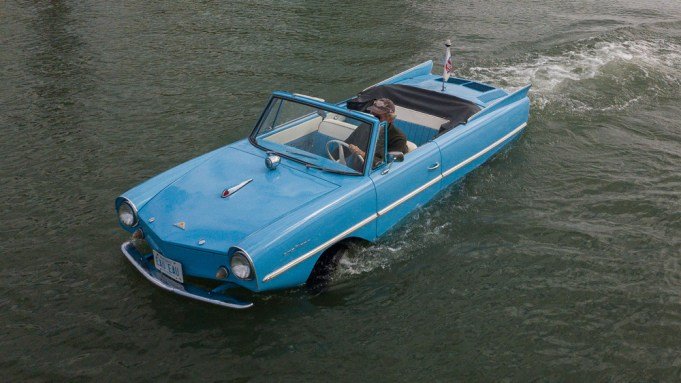The Sixties-Period Amphicar 770 Is a 4-Wheeler That Loves Water, and This One’s Cruising to Public sale

Unlike the unrealized promise of flying automobiles (prototypes notwithstanding), there does exist a car capable of acting like a boat. It’s a vehicle that can drive right down a lakeside ramp and into the water. A novel, short-lived experiment, the Amphicar 770 was launched at the New York Auto Show in 1961.
The Amphicar (Amphibious + Car) was the product of German designer Hans Trippel, who was also the author of the original Mercedes-Benz “Gullwing” door detail. The model 770 was manufactured by the Quandt Group (the Quandt family owns BMW today) at facilities in Lübeck and Berlin. The Germans had ample experience building amphibious vehicles, including the Volkswagen Schwimmwagen, 15,000 examples of which were built by Volkswagen and Porsche, mostly used by the Nazis during World War II, and Trippel’s own SG6, a vehicle put to similar nefarious uses.
The 1962 Amphicar 770 crossing the auction block through RM Sotheby’s on January 25.
Darin Schnabel, courtesy of RM Sotheby’s
The Amphicar is an altogether friendlier machine, one capable of motoring on land and water, although accomplishing neither particularly well. Surprisingly, 3,878 were produced by the end of 1963, when complete production was stopped, although subsequent vehicles were built through 1965 from assembled bodies and warehoused parts. Finished Amphicars continued being sold through 1968.
Performance was modest, even for the day. It’s top speed in water is seven knots, and it can reach 70 mph on dry land. Steering on the road is essentially the same as that of a conventional car, but in the water, the Amphicar “steers” with its front wheels, making it less maneuverable than a real boat. Equipped with navigation lights and a flag—as mandated by the U.S. Coast Guard—the Amphicar has 13 critical lubrication points that owners have to grease after emerging from the water, one of which requires removal of the rear seat.

The vehicle is capable of motoring on land and water, although it accomplishes neither particularly well.
Darin Schnabel, courtesy of RM Sotheby’s
Designer Hans Trippel situated a four-cylinder engine at the rear, in classic VW-think. It is, however, not an air-cooled flat-four but a 1.2-liter Triumph Herald inline-four engine. Shifted by a four-speed manual transmission, it makes a not-so-staggering 43 hp, which is sufficient to motivate the 2,324-pound Amphicar on the tarmac. The rear-wheel-drive layout also turns two reversible propellers, located under the rear bumper, with a second gear lever engaging forward or reverse drive in water. Shifting into first gear as well as drive to the propellers when approaching a boat ramp, the Amphicar can hoist itself out of the water. The mudskipper—that comical and ungainly fish that crawls onto the beach to revel in terrestrial delights—immediately comes to mind.

Weighing in at 2,324 pounds, the 43 hp Amphicar 770 has two reversible propellers located under the rear bumper.
Darin Schnabel, courtesy of RM Sotheby’s
Today, one might see a veritable flotilla of Amphicars on Lake Como during the annual Concorso d’Eleganza Villa d’Este, reminding classic car lovers that sometimes, more fun can be had driving—or captaining—a slow car fast, than a fast car slow. U.S. President Lyndon B. Johnson owned an Amphicar. Quite the practical joker, he would sometimes take visitors to his Texas ranch on a downhill ride in his Amphicar, directly into his lake, shouting that the brakes had failed! In September of 1965, two Amphicars crossed the English Channel. So, like the mudskipper, the Amphicar is more accomplished than its appearance suggests.

U.S. President Lyndon B. Johnson owned an Amphicar.
Patrick Ernzen, courtesy of RM Sotheby’s
Would-be owners would be wise to attend RM Sotheby’s auction held at the classic Frank Lloyd Wright–designed Arizona Biltmore Resort & Spa, on Thursday, January 25. That’s when, and where, this cheerful blue example is estimated to fetch as much as $90,000, although it’s offered without reserve.
Click here for more photos of this 1962 Amphicar 770.

The 1962 Amphicar 770 being auctioned through RM Sotheby’s on January 25.
Darin Schnabel, courtesy of RM Sotheby’s
Authors
-

Robert Ross
Automotive editorial consultant Robert Ross began his publishing career in 1989, and has worked with Robb Report from 2001 to present writing about art, design, audio and especially cars—new and old…
Read More
Source: Robb Report



